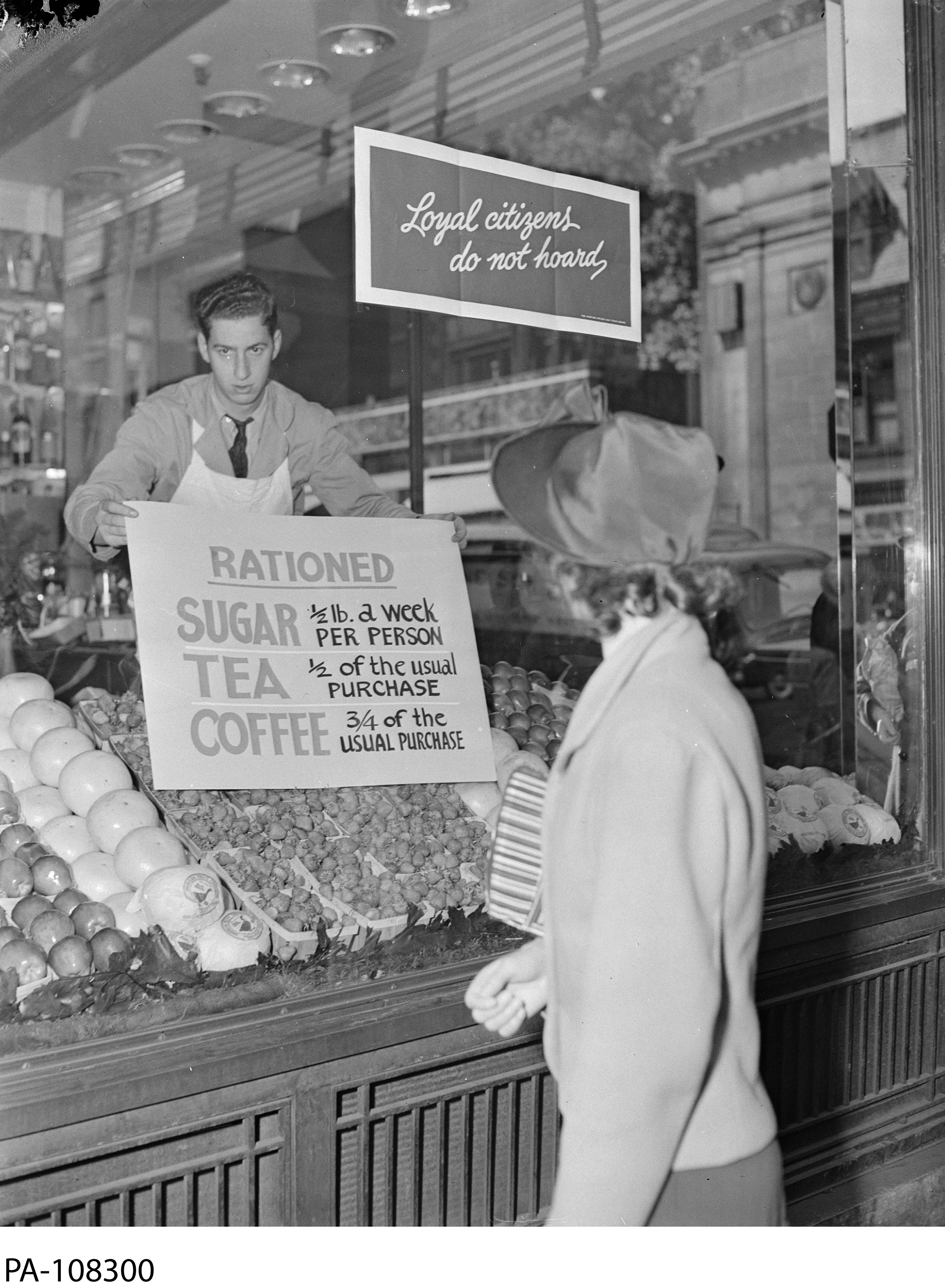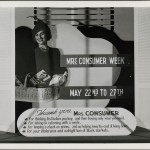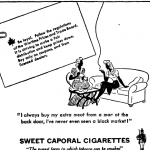Today when people think of the black market, they picture the seedy underworld of society buying and selling firearms and other controlled or illegal goods, but sixty years ago it was a different beast. At the height of World War II, the government imposed strict controls on everything from rent to food to fuel. Every citizen was issued a ration book, and if they wanted to buy a rationed item legally, they had to provide a ticket from that book. This included meat, tea and coffee, car tires, cigarettes, and women’s nylons. Even items that were not rationed were closely controlled, because manpower, industrial energy, and materials were all needed to fuel the war effort.
These strict controls were managed by the Wartime Prices and Trade Board (WPTB), whose job was to regulate every aspect of trade in Canada, including wage and rent controls, export control and rationing — all for the good of the war effort. However, the WPTB was woefully understaffed and individuals and businesses regularly cheated the system. The WPTB Enforcement Branch did get some aid from local police and the RCMP, but even these forces lacked the resources and manpower to adequately squash illegal trade — largely due to their men signing up to fight in Europe and rapidly expanding enforcement responsibilities.[1]
Many civilians in Canada felt disconnected from the war in Europe, while many businesses felt that the wartime controls hampered their ability to keep the doors open, with price ceilings set based on the low prices of the depression years. As a result, a black market in common goods quickly emerged. This was accompanied by what officials considered to be a black market in accommodations. The black markets were especially prevalent in Western Canada, and particularly in Alberta, because many felt that the WPTB was securing an unfair surplus for Central Canada, leaving the West to scrape by. While there are no specific statistics for Edmonton, the RCMP reports for Alberta tell the story well. From April 1942 to March 1943 they investigated 62 WPTB offences in Alberta, of the 212 countrywide.[2] In 1943-44 this increased to 118, out of 485, and in 1944-45 it was up to 351 of 769 WPTB investigations.[3] The trend peaks in between 1945 and 1946 with 717 of 2,114 investigations taking place in Alberta — more than either Ontario or Quebec. This made up more than a quarter of the federal investigations in Alberta for that year.[4]
The black market in Edmonton was exacerbated by the influx of Americans, who began to show up in force in 1942 for the construction of the Alaska Highway and the Northwest Staging Route. This also created a unique facet to the Edmonton black markets. The US soldiers, who many resented, brought with them large quantities of subsidized cigarettes, which were a heavily rationed substance in Canada. Civilians quickly organized a network to trade with these soldiers and distribute the cheap and plentiful American cigarettes to those willing to pay a premium.[5] The WPTB and RCMP remained vigilant though, and announced on May 31, 1943 the arrest of Edmonton residents, John Clydesdale and Bruce Laidlaw, for the illegal possession of American cigarettes. They were both fined $50 (about $690 today), and their illegal hoard was seized — over 4,200 cigarettes in all.[6] Just six days before, the RCMP arrested two American black marketeers, Chris Needham and Robert Rado. Needham and Rado were accused of running an extensive black market operation on the side, dealing in American cigarettes, coffee, tea, butter, gasoline, liquor and shotgun shells. The men purchased the goods under the names of their American employers who were operating in Edmonton, and then distributed them to both citizens on the street and retailers across the city. Reported among the goods seized were over $2,000 worth of cigarettes (about $27,600 today).[7]
Food and cigarettes weren’t the only common black market items. Tires, cars and heavy machinery were regularly traded on the black market, and it led to increased theft as people tried to cash in on the newfound trade. One Edmonton man recounted selling his car for more than $600 and when they filled out the official sales paperwork, the dealer filled in $325 as the sale price, neatly circumventing the honours system that the WPTB had enacted.[8] Another Edmontonian, who worked for OK Construction during the war, reported leaving work only to find two of his tires had been stolen right off his car, which was parked just outside his office.[9] Tire thefts became such an epidemic that the WPTB ran a series of ads in newspapers asking motorists to record their tires’ serial numbers in order to curb black market tire sales.[10]
With wartime austerity and overcrowding due to the influx of Americans and rural workers, even housing became a part of Edmonton’s black market trade. The WPTB set the ceiling for rent at $25 per month and required that all landlords register their properties, but many enterprising Edmontonians chose to cash in on the housing shortage, creating an illegal market in housing. Americans were a prime target for such predatory landlords, with stories appearing in the news showcasing victims of black market housing. Two such men complained that “[they had] been charged from $25 to $40 for a basement or attic room, and $10 for a heated garage!… Another time [they] paid $22.50 for 18 days in [a room] sublet… by tenants who were paying only $52.50 per month for the whole apartment.”[11]
Unfortunately, experiences like this weren’t uncommon, with rents reaching as high as $105 per month for some houses.[12] Tenants often turned in their landlords to the WPTB when the situation became unbearable, but there were still those who were afraid that they would be kicked out to live on the street. Homeowners looking to sell capitalized on the high demand for housing as well, with profits rumoured at 300%, well above the WPTB regulated rates.[13]
The black market in Edmonton was largely accepted by citizens, most of whom felt that cheating on wartime rationing was acceptable because they were largely untouched by the war raging in Europe. With the end of the war in September 1945, many of the WPTB’s restrictions were lifted, and life more or less returned to normal. Some commodities continued to have price controls set by the Board until 1951 in order to curb postwar inflation, but mostly the black markets died with the end of the war. The Americans returned home, leaving hundreds of new wartime homes for native Edmontonians and the basics of life were no longer rationed.
©2015 Robert Morrison
[1] Report of the Royal Canadian Mounted Police. n.p.: Ottawa, Edmond Cloutier, 1945. P. 11.
[2] Report of the Royal Canadian Mounted Police. n.p.: Ottawa, Edmond Cloutier, 1943. P. 77.
[3] Report of the Royal Canadian Mounted Police. n.p.: Ottawa, Edmond Cloutier, 1944, P. 77 and Report of the Royal Canadian Mounted Police. 1945, P. 89.
[4] Report of the Royal Canadian Mounted Police. n.p.: Ottawa, Edmond Cloutier, 1946. P. 105.
[5] Tingley, Kenneth W., ed. For King and Country: Alberta in the Second World War. Edmonton: Provincial Museum of Alberta, 1995. Print. P. 149.
[6] “Edmonton Men Fined.” The Gazette [Montreal, QC] 1 June 1943: 9. Google News Archive. Google. Web. 12 Oct. 2015. <https://news.google.com/newspapers?nid=HoB7MX3m0LUC>.
[7] “US Goods Bought in Black Market.” The Gazette [Montreal, QC] 25 May 1943: 9. Google News Archive. Google. Web. 12 Oct. 2015. <https://news.google.com/newspapers?nid=HoB7MX3m0LUC>.
[8] Keshen, Jeff. Saints, Sinners, and Soldiers: Canada’s Second World War. Vancouver: UBC, 2004. Print. P. 96.
[9] Edmonton Journal
[10] “News of the Week from the Wartime Prices and Trade Board.” Bassano Recorder 21 May 1942: 5. Peels Prairie Provinces. University of Alberta. Web. 12 Oct. 2015. <http://peel.library.ualberta.ca/newspapers/BSR/1942/05/21/5/Ar00508.html>.
[11] “The Journal Letter Box.” Edmonton Journal 11 Nov. 1942: 4. Google News Archive. Google. Web. 12 Oct. 2015. <https://news.google.com/newspapers?nid=gYAb_yFic6IC>.
[12] Keshen, Jeff. “One for All or All for One: Government Controls, Black Marketing and the Limits of Patriotism, 1939-1947.” Journal of Canadian Studies 29.4 (1994): 111-43. ProQuest. Web. 12 Nov. 2015.
[13] Keshen, Jeff. “One for All or All for One: Government Controls, Black Marketing and the Limits of Patriotism, 1939-1947.” Journal of Canadian Studies 29.4 (1994): 111-43. ProQuest. Web. 12 Nov. 2015.



